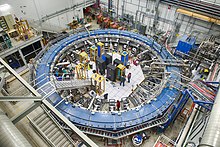
Back Muon g-2 Catalan Muon g-2 German Experimento Muón g-2 Galician Muon g−2 Italian ミューオンg-2実験 Japanese Мюон g−2 Kazakh Múon g-2 Portuguese Muon g-2 Russian Mion g-2 Slovenian 缪子g-2 Chinese

Muon g − 2 (pronounced "gee minus two") is a particle physics experiment at Fermilab to measure the anomalous magnetic dipole moment of a muon to a precision of 0.14 ppm,[1] which is a sensitive test of the Standard Model.[2] It might also provide evidence of the existence of new particles.[3][4][5]
The muon, like its lighter sibling the electron, acts like a tiny magnet. The parameter known as the "g factor" indicates how strong the magnet is and the rate of its gyration in an externally applied magnetic field. It is this rate of gyration that is indirectly measured in the Muon g − 2 experiment.
The value of g is slightly larger than 2, hence the name of the experiment. This difference from 2 (the "anomalous" part) is caused by higher-order contributions from quantum field theory. In measuring g − 2 with high precision and comparing its value to the theoretical prediction, physicists will discover whether the experiment agrees with theory. Any deviation would point to as yet undiscovered subatomic particles that exist in nature.[6]
On July 9, 2023 the Fermilab collaboration concluded the experiment after six years of data collection.[7] The initial results (based on data from the first year of the experiment's operation) were released on April 7, 2021.[8][9][10] The results from the first three years of data-taking were announced in August 2023.[4][5] The final results, based on the full six years of data-taking, are planned to be released in 2025.[7]
- ^ "Muon g − 2 Experiment" (main page). Fermilab. Retrieved April 26, 2017.
- ^ Keshavarzi, Alex; Khaw, Kim Siang; Yoshioka, Tamaki (January 22, 2022). "Muon g − 2: A review". Nuclear Physics B. 975: 115675. arXiv:2106.06723. Bibcode:2022NuPhB.97515675K. doi:10.1016/j.nuclphysb.2022.115675. S2CID 245880824.
- ^ Gibney, Elizabeth (April 13, 2017). "Muons' big moment could fuel new physics". Nature. 544 (7649): 145–146. Bibcode:2017Natur.544..145G. doi:10.1038/544145a. PMID 28406224. S2CID 4400589.
- ^ a b Miller, Katrina (August 10, 2023). "Physicists Move One Step Closer to a Theoretical Showdown – The deviance of a tiny particle called the muon might prove that one of the most well-tested theories in physics is incomplete. + comment". The New York Times. Archived from the original on August 11, 2023. Retrieved August 11, 2023.
{{cite news}}: CS1 maint: bot: original URL status unknown (link) - ^ a b Cite error: The named reference
nature 2023Aug10was invoked but never defined (see the help page). - ^ "Muon g − 2 Collaboration to solve mystery". Muon g − 2 Experiment (Press release). Fermilab. Archived from the original on July 1, 2017. Retrieved April 30, 2017.
- ^ a b Cite error: The named reference
endofdatatakingwas invoked but never defined (see the help page). - ^ "First results from the Muon g − 2 experiment at Fermilab" (Press release). Fermilab. March 7, 2021.
- ^ Overbye, Dennis (April 7, 2021). "Finding from particle research could break known laws of physics". The New York Times. Retrieved April 7, 2021.
It's not the next Higgs boson – yet. But the best explanation, physicists say, involves forms of matter and energy not currently known to science.
- ^ Marc, Tracy (April 7, 2021). "First results from Fermilab's Muon g − 2 experiment strengthen evidence of new physics" (Press release). Fermilab. Retrieved April 7, 2021.
© MMXXIII Rich X Search. We shall prevail. All rights reserved. Rich X Search